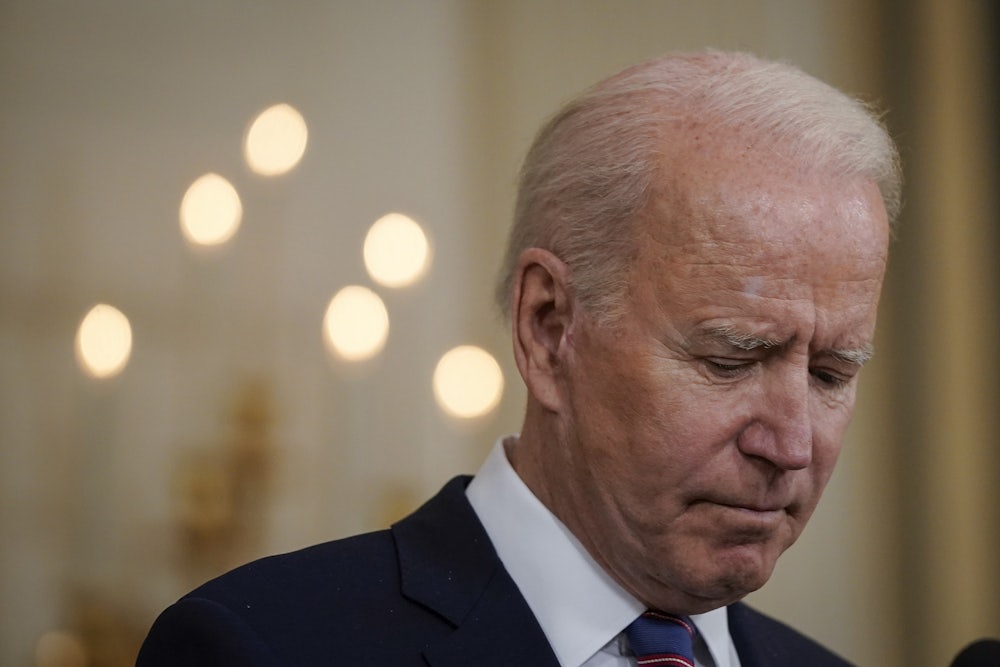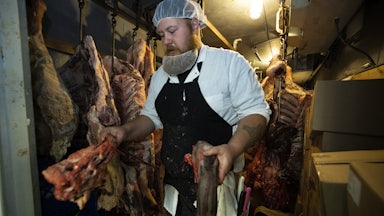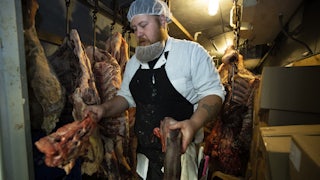Among the various ways President Donald Trump caused more Americans to die needlessly from Covid-19 was by failing to issue a legally enforceable “emergency temporary standard” to protect workers. The 1970 Occupational Safety and Health Act permits the Labor Department to impose such a standard without consulting Congress, a move that the AFL-CIO strenuously urged, but the Trump administration wouldn’t budge. Then-candidate Joe Biden attacked Trump mercilessly for this negligence, and on his first day in office President Biden issued an executive order to initiate prompt action.
Now the Labor Department is ready to go with two emergency standards—one for health care workers and another for everybody else—but the White House, fearful of setting off angry protests, is dithering.
Under the January 21 executive order, the Labor Department’s Occupational Safety and Health Administration was supposed to issue its emergency temporary standard by March 15. (The executive order said the standard would be issued on that date only if judged “necessary,” but that was a formality.) The Ides of March came and went. Now it’s mid-April, and OSHA still hasn’t issued the promised standard—a costly delay for any government order that includes the words “emergency” and “temporary.” To make matters worse, there are whisperings abroad that the White House may drop the whole idea.
“OSHA has been working diligently, as appropriate, to consider what standards may be necessary,” a Labor Department spokesperson told Bloomberg News on April 12, “and is taking the time to get this right.” That sounded ominous. A Labor Department spokesperson told Bloomberg Law the previous week that Labor Secretary Marty Walsh “reviewed the materials, and determined that they should be updated to reflect the latest scientific analysis of the state of the disease.” But Walsh is actually quite impatient, I’m told, to get the rule out. The holdup is at the White House.
“My concern is that White House officials think that vaccination alone will be enough to stem this pandemic,” David Michaels told The New Republic. Michaels is an epidemiologist at the George Washington University School of Public Health; before that, he ran OSHA under President Barack Obama.
We can’t vaccinate our way out of this crisis, Michaels explained, for a variety of reasons. Four months into a fairly successful vaccination effort, Covid-19 cases are going up, not down, and they’ve been doing so for four weeks. More transmissible Covid variants have taken hold—with B.1.1.7. being the most widespread—accounting for the majority of new Covid cases in Florida, Michigan, Minnesota, and Tennessee. Businesses are opening back up, and in March the economy added a stunning 916,000 jobs. That’s a sign that the public health crisis is ebbing. (Hooray!) But this reopening poses health dangers of its own if those returning workers aren’t protected sufficiently from Covid-19. “If we don’t control workplace transmissions,” Michaels said, “the pandemic will continue to worsen.”
None of this is news to President Biden, who’s been begging the states not to drop state mask requirements prematurely. When the Republican governors of Texas and Mississippi did so anyway, Biden got angry and called it “Neanderthal thinking.” Biden’s director of the Centers for Disease Control and Prevention, Rochelle Walensky, expressed similar dismay at Gretchen Whitmer, the Democratic governor of Michigan, the state where Covid-19 is currently most out of control. Whitmer is resisting pleas to issue new public health mandates; this week she asked Biden instead to give Michigan more vaccines. Walensky shot back: “The answer is not necessarily to give vaccine. The answer … is to really close things down.”
Whitmer’s resistance to Covid mandates helps explain why the Biden White House is jittery about issuing an emergency temporary workplace standard. If a Democratic governor is this defiant about Covid restrictions, imagine how angry the MAGA mob will get if the federal government requires every working American to wear a mask on the job (or to take an equivalent precaution). Protests from the business lobby will likely be the least of it, and Trump cultists may be joined by some Democrats who are understandably sick and tired of a pandemic that’s entered its second year.
But a flagging will to maintain state health mandates among governors such as Whitmer is a powerful reason for OSHA to issue its temporary emergency standard now, because if these dominos continue to fall, the federal government will be the only bulwark left. Additionally, if the country is to reopen prematurely, it needs to do so as safely as possible. In Michigan, according to Debbie Berkowitz, worker safety and health program director at the National Employment Law Project, nearly half the new Covid clusters are in workplaces.
Remember meatpackers? Berkowitz testified before Congress last month that “as of mid-February 2021, at least 57,000 meatpacking and poultry workers have been infected with Covid-19, and over 280 have died.” The honor system doesn’t seem to work any better under Biden than it did under Trump. Last week the United Food and Commercial Workers filed an OSHA complaint alleging that Seaboard, a meatpacking plant in Guymon, Oklahoma, failed to report 99 percent of its Covid cases, refused to implement social distancing or erect protective barriers, and didn’t allow workers to quarantine after they were exposed to Covid-19. (The company replied to AP that it “continues to adapt to ensure our … pork processing plant remains a safe place to work while producing much-needed food for tables across our communities and the country.”)
Perhaps OSHA really is “taking the time to get it right,” as its spokesperson says. But time is in short supply, and there are plenty of off-the-shelf state rules to crib from. Virginia imposed a temporary Covid workplace rule way back in July 2020. Capitalism survived in the Old Dominion, and the U.S. Chamber of Commerce registered only mild annoyance. In December, California created its own temporary workplace standards, developed by Cal OSHA chief Doug Parker, whom Biden just nominated to lead OSHA. Washington state and Oregon did the same. If the result was political catastrophe, word hasn’t reached me.
Most states haven’t imposed workplace safety guidelines to protect workers from Covid-19, and likely won’t. Governors want to believe Covid vaccination will rescue their states, but it isn’t moving fast enough to save the day. (In my home jurisdiction of Washington, D.C., the mayor is actually slowing it down.) Twenty-eight percent of the population is vaccinated fully against Covid-19, but that isn’t enough, especially considering that half of that 28 percent is 65 or older, and therefore mostly retired. Many working people have bosses who are acting responsibly to protect them from contracting Covid-19, and if you have the leisure to read this article, then perhaps you’re one of them. But most people have bosses who can never really be counted on to do the right thing. If the Biden administration doesn’t protect these workers, nobody will.








